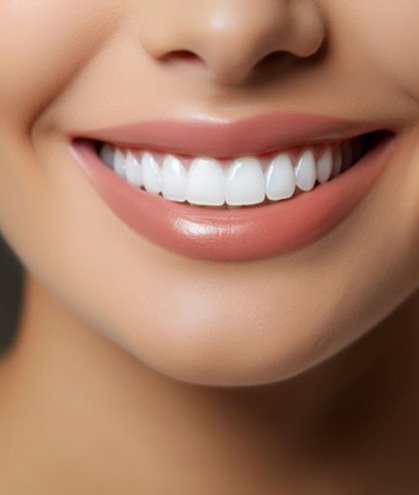Veneers – Dallas, TX
Shells That Create Dazzling Smiles
You may think different smile flaws require varying fixes. Perhaps tooth stains need one treatment, for example, while chips need some other kind. However, one option addresses several such flaws at once: dental veneers! By getting these unique shells, you can revamp your grin from the ground up. Your Dallas dentist is even happy to tell you more. So, keep reading to learn more about them and how they benefit your teeth.
What are Dental Veneers?

In essence, dental veneers are thin shells that dentists place on teeth. They aim to hide many smile flaws – stains, chips, cracks, fractures, and misalignments. Due to using high-quality material, they usually blend seamlessly with the rest of your smile.
In most cases, veneers are made out of dental-grade porcelain. This makeup allows dentists – including our own Dr. Tyagi – to customize the shells’ color, size, and shape. You’ll then get amazing results that suit your smile very well. Better yet, the porcelain ensures a patient’s veneers are long-lasting and stain-resistant.
The Process of Getting Veneers

In general, veneers involve a multi-step treatment process. Getting them thus requires three particular steps: the consultation, the “prep visit,” and the final placement. Each of these phases is crucial to a veneer procedure’s success.
As you might expect, the consultation is a preliminary visit with Dr. Tyagi. This appointment lets you convey treatment goals to our office, including what you want from veneers. At the same time, the visit helps us learn your oral health status, medical history, and general patient background. Based on these factors, our team can decide if veneers are right for you.
After the consult, you’ll proceed to the “prep visit.” This stage prepares teeth for veneers by cleaning them and removing some of their enamel. From there, our team will take a dental impression – a model of your mouth used to make the prosthetics. Your final shells won’t be ready for a few weeks, so you’ll wear temporary ones in the meantime.
At the final placement visit, we’ll set your now-ready veneers onto your teeth. Dr. Tyagi will then make last-minute adjustments so the shells work well.
The Benefits of Veneers

Once you get veneers, you’ll enjoy a wide range of benefits. These typically include:
- A Beautiful Smile: Being made of porcelain, veneers match your other teeth. That means they’re highly lifelike and blend seamlessly with their surroundings.
- Stain-Resistance: As it happens, veneers’ porcelain material makes them stain-resistant. This latter feature ensures that treated teeth are less likely to discolor.
- Versatile Fixes: Veneers normally cover the whole fronts of teeth, something that lets them fix a wide range of smile flaws. Whether it’s tooth stains, chips, cracks, or even dental misalignment, you can count on them to help.
- Long-Lasting Results: On average, a veneer has a 15-year lifespan. A well-maintained one, however, can last for 30 years or more. Therefore, there’s a good chance your treatment results could last a lifetime.
Understanding the Cost of Veneers

Understandably, many patients are interested in enhancing the appearance of their smile with veneers, but they have some concerns about the cost of treatment. During your FREE cosmetic consultation, we will be happy to answer your questions and provide you with a personalized cost estimate. Although veneers tend to have a higher price than other services, they are an excellent value and a worthwhile investment for image-conscious individuals.
Cost vs. Cosmetic Dentistry: What Is Right for Me?

Veneers are just one potential way to achieve your aesthetic goals for your smile. We offer a number of services at different price points. Here is an overview of some popular options, along with generalized cost information:
- Braces and clear aligners tend to cost thousands of dollars. They are great for addressing cases of misalignment that pose a threat to a person’s oral health. However, treatment can take several months or longer, and orthodontia will not enhance the color or shape of your teeth.
- Teeth whitening. Teeth whitening may cost just a few hundred dollars, and it is an effective way to get rid of dental stains. However, the results are temporary, and it cannot improve the shape or positioning of teeth.
- Direct bonding. Also called cosmetic bonding, this service is very affordable. It looks similar to veneers at first. However, it is not particularly durable; it usually has to be redone every few years.
- Gum recontouring. The cost of gum recontouring depends on the extent of the procedure. It is perfect for many patients who want a more proportionate smile.
- Veneers tend to cost more than other treatments, but they present a great value. They are sometimes regarded as an “all in one” cosmetic procedure because they can address discoloration, minor misalignment, and more — all within a matter of weeks! They are truly a smart investment for people who want a perfect smile.
How to Make Veneers Affordable

Veneers are almost never covered by dental insurance because they are regarded as a purely elective treatment. However, there may be other provisions you can take advantage of to fit your dream smile into your budget:
- A FREE cosmetic consultation. You can take the first step toward your aesthetic goals for absolutely nothing out of pocket.
- If you would like to break up the cost of your treatment into manageable monthly installments, you may qualify for low-interest financing. We accept both CareCredit and Lending Club. We also have our own in-house financing option.
- Treatment adjustments. We may be able to use fewer veneers to enhance your look. Later, we may be able to perform further treatments if you would like.
Our team would love to help you achieve a smile that you are proud to show off. To learn more about veneers and their cost, book your complimentary cosmetic consultation. We look forward to serving you!
Veneers FAQs
Is It Painful to Get Veneers?
Normally, no – it isn’t painful to get veneers. Dentists work to ensure the process is smooth and comfy. As such, you shouldn’t feel any discomfort from a veneer treatment.
You see, Dr. Tyagi will numb your mouth before veneer placement. That means you won’t sense pain from their work. At most, you’ll only feel a slight pressure as he preps your teeth.
Of course, you may have some post-treatment discomfort. Some patients feel sensitivity and pain when multiple veneers are placed. Similarly, you might experience “bonding sensitivity” – a sharp pain from biting into something hot or cold. Still, such symptoms are temporary and fade within a few days.
Do Veneers Give You a Lisp?
For some, getting veneers can lead to a lisp. However, this effect is short-lived and disappears fairly quickly.
A veneer lisp usually stems from muscle memory. When the tongue isn’t (yet) used to the shells’ presence, it can struggle to pronounce certain words. Patients may then lisp as they make the “s” and “v” sounds.
Luckily, this lisp stops over time. The tongue eventually adjusts on its own, learning to account for the veneers. That said, practicing certain sounds can speed up the process. Dr. Tyagi could also reduce your veneers’ thickness.
Can Veneers Be Used for Bite Corrections?
Veneers can be used for bite corrections. Their effectiveness, though, depends on the problem’s severity and nature.
For example, say that you have a mild open bite. Veneers could make the affected teeth look longer and wider. That way, they’d appear to line up correctly. (Note, though, that the veneers wouldn’t actually move your teeth.)
Even so, veneers aren’t ideal for every bite dilemma. A dentist will only suggest them when the issue doesn’t cause major oral health concerns. As such, an orthodontic treatment may be better in some cases. You could then have veneers placed afterward.
Can You Whiten Veneers?
Sadly, whitening procedures can’t whiten veneers. They don’t have any effect on the porcelain shells. Therefore, stained veneers should be replaced or shaded instead.
It all comes down to how whitening works. Normally, bleaching gel seeps into your enamel to remove tooth stains. Veneers, though, are non-porous – they won’t let the gel reach beneath their surface. So, a whitening will just lead to an unevenly-colored smile.
Despite these facts, a few workarounds do exist. You could undergo a whitening treatment before you get veneers. This approach allows your veneers to be color-matched to your newly whitened teeth.
